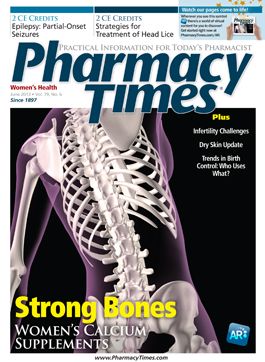The Management of Postherpetic Neuralgia: An Opportunity to Rethink Gabapentin
The incidence of herpes zoster increases with age, and about 10% to 15% of patients will develop postherpetic neuralgia.
This article was sponsored by Depomed Inc.
Background
Herpes zoster, also referred to as shingles, is a condition caused when the varicella zoster virus (VZV) contracted earlier in life (usually as chicken pox) becomes reactivated after a period of latency.1 After the initial infection, VZV often lies asymptomatically within the ganglia of sensory cranial nerves and spinal dorsal roots. The reactivation of VZV is associated with advanced age and immunosuppression, which result in decreased immunity to VZV. Diminished immunity spurs the migration of the virus along the sensory nerves to the skin, resulting in a painful rash characterized by a band of blisters that is typically localized to 1 or 2 dermatomes.1,2 The incidence of herpes zoster increases as patients age, with a sharp increase at approximately 50 years of age and a doubling by the age of 80 years.1,3
Pain is the most common symptom in patients experiencing an episode of herpes zoster. Whereas most patients experience a spontaneous resolution of their symptoms over time, about 10% to 15% develop a neuropathic complication of herpes zoster called postherpetic neuralgia (PHN).3 PHN is defined as pain that persists more than 3 months after the rash from herpes zoster has healed. The pain associated with PHN has been described as aching, stabbing, and shock-like, and may cause unbearable itching, altered sensitivity to touch, and increased sensitivity to minor stimuli.1,3 Pain associated with PHN has been reported to adversely affect mood, work, sleep, and quality of life, and may lead to social withdrawal and depression.1 Although there is no definitive algorithm for the treatment of PHN, guidelines recommend opioids, tricyclic antidepressants, and anticonvulsants as first-line options for neuropathic pain.3-5 Further complicating treatment, many medications used to treat PHN may require long titration periods and can be associated with therapy-limiting adverse events which prevent patients from achieving an optimal therapeutic dose.2
Treatment of PHN with GRALISE: Optimizing the Delivery of Gabapentin
Gabapentin has a well-established history as a first-line treatment for PHN. However, the optimal therapeutic daily dose (1800 mg) is difficult to achieve and maintain because the bioavailability of gabapentin decreases as the dose increases due to saturation of the gabapentin transport pathway.6,7 Other challenges during gabapentin treatment include a complex titration scheme and the need for 3-times-daily dosing.8 A novel formulation of gabapentin (GRALISE) has been developed that utilizes gastroretentive technology to promote retention of the tablet in the stomach, allowing gabapentin to be slowly released to its transporters in the small intestine. Through the use of this technology, gabapentin is delivered to the optimal site of absorption, the duodenum, over an extended period of time (8 to 10 hours).7 GRALISE, which is dosed once daily, achieves a higher maximal plasma concentration and takes longer to reach that maximal concentration as compared with immediate-release gabapentin dosed 3 times daily at steady state.9,10 GRALISE is indicated for the management of PHN.11 When taken with the evening meal, peak drug concentrations occur overnight (Figure 1).7 The most common adverse reaction to GRALISE (≥5% and twice placebo) is dizziness.7
Clinical Safety and Efficacy of GRALISE in Patients with PHN
The safety and efficacy of GRALISE were evaluated during a phase 3, randomized, double-blind, placebo-controlled study of 452 patients who had PHN for at least 6 months but fewer than 5 years and a daily pain rating of 4 or higher on an 11-point scale. Patients received a starting dose of GRALISE 300 mg with dose titrations up to 1800 mg in the first 2 weeks; patients continued taking the 1800 mg dose for another 8 weeks, followed by 1 week of dose tapering. Efficacy was evaluated using an 11-point numerical scale as a self-assessment tool to rate average daily pain. Patients treated with GRALISE experienced significant improvements in pain scores (-2.12) compared with those who received placebo (-1.63) (P = .013).12'
Across all GRALISE clinical trials, other than dizziness, the most common adverse reactions included somnolence (4.5%), headache, peripheral edema (3.9%), diarrhea, dry mouth, and nasopharyngitis. The types and incidences of adverse events were similar across age groups except for peripheral edema, which tended to increase in incidence with age (Figure 2).11,13
GRALISE is contraindicated in patients who have demonstrated hypersensitivity to the drug or its ingredients. Antiepileptic drugs (AEDs) including gabapentin, the active ingredient in GRALISE, increase the risk of suicidal thoughts or behavior in patients taking these drugs for any indication. Patients treated with any AED for any indication should be monitored for the emergence or worsening of depression, suicidal thoughts or behavior, and/or any unusual changes in mood or behavior. The safety and efficacy of GRALISE in patients with epilepsy has not been studied.11
Role of the Pharmacist and Instructions for Use
Due to its patented formulation and pharmacokinetic profile, it is important to note that GRALISE is non-substitutable with other gabapentin products; there are no AB-rated equivalents.11 Upon dispensing GRALISE, pharmacists should ensure that patients are informed about the proper titration schedule and evening dosing time. GRALISE should be taken with the evening meal because food (high-fat meals in particular) will delay gastric emptying and increase drug retention time, maximizing the benefits of the drug delivery technology.10 Because of the novel delivery system, GRALISE tablets should not be crushed, split, or chewed. An increase in gabapentin AUC values has been reported when administered with hydrocodone or morphine. It is recommended that GRALISE be taken at least 2 hours following antacid administration. In patients who discontinue treatment, GRALISE should be withdrawn gradually over a minimum of 1 week or longer (at the discretion of the prescriber).11
GRALISE should not be used in women who are pregnant or lactating unless the potential benefits clearly outweigh the risks. Furthermore, the safety and effectiveness of GRALISE in the management of PHN in patients less than 18 years of age have not been studied. Because gabapentin is not metabolized, studies have not been conducted in patients with hepatic impairment. In patients with impaired renal function, the dosage should be adjusted; do not administer GRALISE in patients with creatinine clearance less than 30 mL/min or in patients undergoing hemodialysis, and reduce the dose of GRALISE in patients with age-related compromised renal function.11
Summary
PHN is a painful condition that may adversely impact quality of life. GRALISE utilizes a proprietary technology to optimize oral drug delivery of gabapentin through gastric retention when taken with an evening meal, allowing for once-daily dosing and a higher maximal plasma concentration and similar AUC as compared with immediate-release gabapentin dosed 3 times daily at steady state. Equally important, treatment with GRALISE resulted in significant improvements in pain scores versus placebo, and low rates of adverse events, providing clinicians with an effective first-line option for the management of pain due to PHN.
Please see Important Safety Information throughout. For additional safety information, please see full Prescribing Information and Medication Guide.
References
- Harpaz R, Ortega-Sanchez IR, Seward JF; Advisory Committee on Immunization Practices (ACIP) Centers for Disease Control and Prevention (CDC). MMWR Recomm Rep. 2008;57(RR-5):1-30; quiz CE2-4.
- Sampathkumar P, Drage LA, Martin DP. Mayo Clin Proc. 2009;84(3):274-280.
- Cappuzzo KA. Clin Interv Aging. 2009;4:17-23.
- Dubinsky RM, Kabbani H, El-Chami Z, Boutwell C, Ali H; Quality Standards Subcommittee of the American Academy of Neurology. Neurology. 2004;63(6):959-965.
- Dworkin RH, O’Connor AB, Audette J, et al. Mayo Clin Proc. 2010;85(3 suppl):S3-S14.
- Stewart BH, Kugler AR, Thompson PR, Bockbrader HN. Pharm Res. 1993;10(2):276-281.
- Argoff CE, Chen C, Cowles VE. Expert Opin Drug Deliv. 2012;9(9):1147-1160.
- Neurontin [prescribing information]. New York, NY: Parke-Davis; July 2012.
- Gordi T, Hou E, Kasichayanula S, Berner B. Clin Ther. 2008;30:909-916.
- Chen C, Cowles VE, Hou E. J Clin Pharmacol. 2011;51:346-358.
- Gralise [prescribing information]. Newark, CA: Depomed, Inc; December 2012.
- Sang CN, Sathyanarayana R, Sweeney M; DM-1796 Study Investigators. Clin J Pain. 2013;29(4):281-288.
- Irving GA, Sweeney M. J Pain Res. 2012;5:203-208.
GRA-403-P.1


